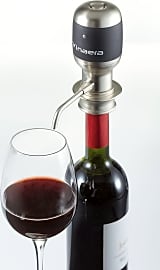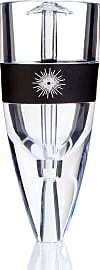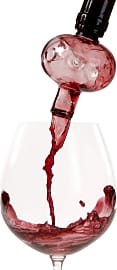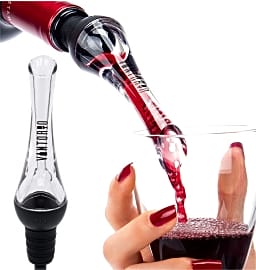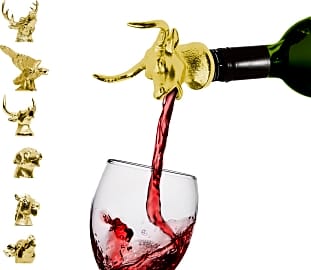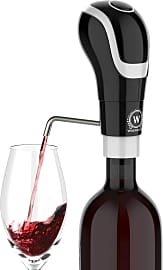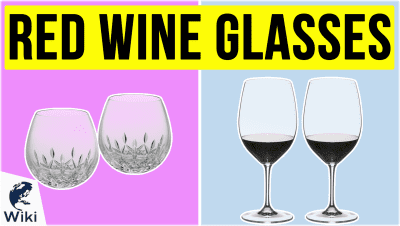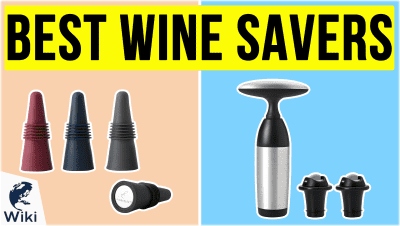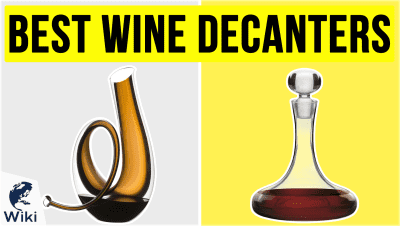The 10 Best Wine Aerators

This wiki has been updated 35 times since it was first published in October of 2016. Even the best wines can need a little bit of care before consumption to ensure you get the most from them. Allowing any variety to breathe for 30 minutes or more brings out the full flavor, softens any sharpness, and enhances its bouquet. However, if you are in a rush, one of these aerators can enhance the quality of your wine in as little time as it takes to pour a glass. When users buy our independently chosen editorial picks, we may earn commissions to help fund the Wiki.
Editor's Notes
April 22, 2020:
While we might all like to claim that we are patient people, everything changes once you pop the cork and realize that you have to wait anywhere from 30 minutes to two hours to let your wine aerate if you want to enjoy it at its best. Rather than sit there and pout, you can use one of these smartly-designed aerators to get a perfect glass of vino in seconds instead of hours.
If you are trying to impress your dinner guests not just with the taste, but also the serving of your drink of choice, you'll want to look at the Vinturi V1071 Deluxe, Centellino Areadivino, and Soireehome In Bottle SO1006. These three options make the act of serving a spectacle for various reasons. The Vinturi V1071 Deluxe sits in an elegant stand that makes it visually striking when you pour, the Centellino Areadivino has an interesting design that looks like something you might find a mad scientist using in his laboratory, and the Soireehome In Bottle SO1006 lets the wine splash around in a glass bulb as it pours from the bottle to the glass. The Wine by Nine Animal may not make the actual serving a performance, but it is worth mentioning for its metal construction and the charming animal shapes it comes in, including a dog and stag.
If you like all things high tech, you may want to forgo the use of a gravity-based option and instead choose a battery-powered one, like the Viotek Vinaera or Waerator WA-A01. It is claimed that they offer six times the aeration of other methods, though we can't necessarily substantiate this. That being said, they are certainly fun choices. While we aren't huge fans of the design of the Waerator WA-A01, it is significantly more wallet-friendly than the Vinaera.
On the topic of budget-friendly options, few are more so than the simple Haley's Corker 5-in-1. It isn't a very sophisticated item, but the ability to double as a wine saver make it great for anybody who likes to enjoy a glass or two while cooking or having dinner, even if guests aren't around and they won't be able to finish the whole bottle in one sitting.
Special Honors
Williams Sonoma Twister Aerator & Decanter with Stand Set With the Williams Sonoma Twister Aerator & Decanter with Stand Set you can really enjoy your wine in style. The spiral-shaped aerator is crafted from mouth-blown, double-walled glass and has a three-stage oxygenation system, one of which catches sediment. Due to its odd form and delicacy, it comes with stand to keep it safe when not in use. williams-sonoma.com
The Wand Wine Filter If you are looking for ways to make your vino more enjoyable, The Wand Wine Filter may be worth considering, especially if you are prone to getting stuffy or flushed cheeks when you imbibe. Supposedly, by simply swirling one in your wine for a few seconds and then leaving it in the glass for a few minutes afterwards, you can remove a lot of the histamines and sulfites. drinkpurewine.com
What Happens When Wine Is Aerated
Doing so allows the wine to stay in good condition while it ages, and reach its optimal flavor levels when we imbibe it.
The purpose of aerating wine is to induce chemical reactions that can both smooth out its taste and open it up a bit. Two processes happen when wine is aerated: oxidation and evaporation. Introducing oxygen to wine allows the aromas to become more noticeable and will soften its mouthfeel. This is due to the way oxygen breaks down the tannins. Tannins are what cause that harsh, somewhat dry sensation that some wines produce on the cheeks and tongue.
Some oxidation is good for wine, but over-oxidation is bad. Over-oxidation of wine causes it to degrade, resulting in a loss of flavor and aroma. It can also cause it to become more acidic. Ideally, we want to halt the oxidation of wine while in the bottle, and initiate it once the bottle is opened. Doing so allows the wine to stay in good condition while it ages, and reach its optimal flavor levels when we imbibe it. To prevent oxidation when in the bottle, winemakers often add sulfites and sulfides. These compounds act as preservatives.
While sulfites and sulfides do a good job of preserving wine and preventing oxidation, they do have some unwanted side effects. They may cause wine to have some unpleasant aromas, like those of burnt matchsticks, rotten eggs, or onions. This is why we want to induce evaporation after we have opened a bottle of wine and before we drink it. Evaporation can rid wine of some of its undesirable compounds, like sulfides, sulfates, ethanol. All of these compounds are volatile, meaning they quickly evaporate when exposed to oxygen. Ridding the wine of the undesirable volatile compounds allows the desirable aromatic and flavorful ones to become more expressed, resulting in wine that tastes and smells better.
It is not just the added compounds we want to evaporate from wine after opening the bottle, it is also the by-products of the chemical reactions that take place while wine is aging. No matter how many preservatives winemakers add to wine, it will always undergo slight oxidation when in the bottle. The longer a wine ages, the more gasses that will be released inside of the bottle. Aerating wine after opening it gives these off-putting gasses a chance to dissipate from the liquid.
Do You Really Need A Wine Aerator?
Now that we have a thorough understanding of what wine aerators do, let's determine if you truly need one. Obviously, we want to enjoy our wine to the fullest. That means drinking it when the flavors and aromas are at their optimal levels. To ensure that we are doing this, we must give tight wines a chance to breathe and open up, and give overly tannic wines a chance to soften. Simply opening a bottle of wine and letting it sit on the counter isn't enough to cause proper aeration. The narrow neck of a wine bottle doesn't allow for enough oxygen to flow through for proper evaporation. To effectively aerate wine, we have three options: a decanter, a glass, or an aerator.
If you have the patience to let your wine sit for an hour or so in a decanter or wine glass, then an aerator is not needed.
Decanters are vessels designed to hold wine, and sometimes other liquids, while they aerate. These days, they are most often made from glass or crystal, but they have been made from clay, bronze, and other materials throughout history. They are usually big enough to accommodate an entire bottle of wine and have a very wide bottom. Pouring wine into a wide-bottomed decanter allows for more of it to come into contact with the air, promoting quicker oxidization and evaporation. Depending on the type of wine, it may need to sit in a decanter for as little as 30 minutes or as much as three hours.
Those who don't have decanter can replicate the process of decanting wine by simply pouring it into a wide-mouthed red wine glass. As with a decanter, properly aerating wine in a red wine glass may takes as little as 30 minutes or as much as three hours. While it may not have the same aesthetic value of a decanter, it can be just as effective.
Aerators are designed to have the wine poured through them right before serving. They generally come in two styles: handheld and those that attach to the wine bottle itself, but there are some very elaborate freestanding models out there, as well. Unlike decanters and the wine glass method, aerators aerate wine in seconds. The wine will be at an optimal drinking level immediately after passing through an aerator.
So, do you really need a wine aerator? The answer is no, you don't. If you have the patience to let your wine sit for an hour or so in a decanter or wine glass, then an aerator is not needed. On the other hand, if you are like most of us, and generally open up a bottle of wine minutes before you plan on drinking it, then an aerator is your only option to ensure your are drinking your wine at its very best.
Tips On Which Wines To Aerate
Despite what many people may think, not all wines require aeration. It is important to know which wines require it, and which are better off without being aerated.
On the other end of the spectrum, aged red wines that have visible sediment should be aerated, as well.
Any young full-bodied red is a good candidate for aeration. They will often still be very tannic, as they haven't had a chance to age in the bottle. Aerating them will ensure the subtle flavor notes aren't overpowered by the tannins. On the other end of the spectrum, aged red wines that have visible sediment should be aerated, as well. They are better served by aeration in a decanter, though, as this can help remove sediments in addition to opening up the flavor a bit.
Dry, full-bodied white wines can also benefit from aeration. These will usually be white wines that share some similar traits with reds, like having a heavy mouth feel or a higher amount of tannins. Some examples of white varieties that often need aeration are white bordeaux and burgundies and Alsace wines.
Vintage ports are also good candidates for aeration. These are ports that have been aged for somewhere around 20 years. Letting them aerate a bit after opening can help their flavors develop and allow the unwanted aging by-products to dissipate.



